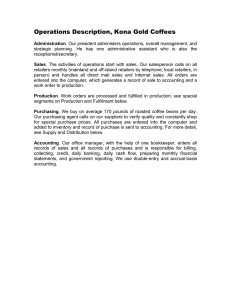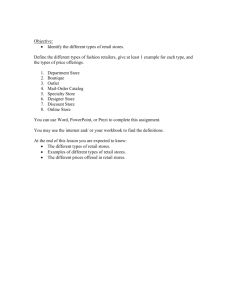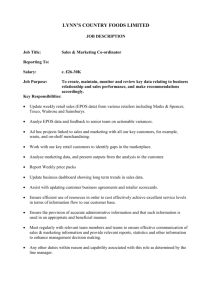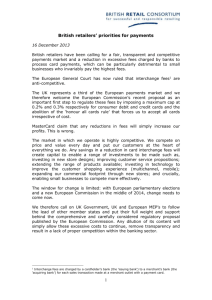Click and collect booms in Europe
advertisement
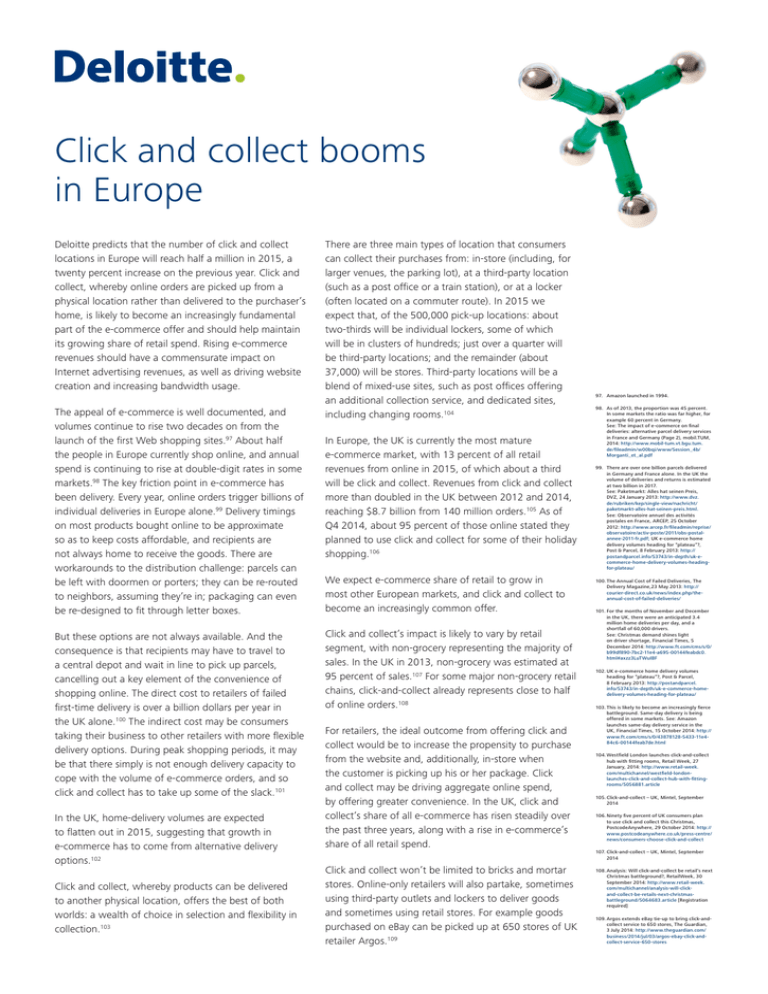
Click and collect booms in Europe Deloitte predicts that the number of click and collect locations in Europe will reach half a million in 2015, a twenty percent increase on the previous year. Click and collect, whereby online orders are picked up from a physical location rather than delivered to the purchaser’s home, is likely to become an increasingly fundamental part of the e-commerce offer and should help maintain its growing share of retail spend. Rising e-commerce revenues should have a commensurate impact on Internet advertising revenues, as well as driving website creation and increasing bandwidth usage. The appeal of e-commerce is well documented, and volumes continue to rise two decades on from the launch of the first Web shopping sites.97 About half the people in Europe currently shop online, and annual spend is continuing to rise at double-digit rates in some markets.98 The key friction point in e-commerce has been delivery. Every year, online orders trigger billions of individual deliveries in Europe alone.99 Delivery timings on most products bought online to be approximate so as to keep costs affordable, and recipients are not always home to receive the goods. There are workarounds to the distribution challenge: parcels can be left with doormen or porters; they can be re-routed to neighbors, assuming they’re in; packaging can even be re-designed to fit through letter boxes. But these options are not always available. And the consequence is that recipients may have to travel to a central depot and wait in line to pick up parcels, cancelling out a key element of the convenience of shopping online. The direct cost to retailers of failed first-time delivery is over a billion dollars per year in the UK alone.100 The indirect cost may be consumers taking their business to other retailers with more flexible delivery options. During peak shopping periods, it may be that there simply is not enough delivery capacity to cope with the volume of e-commerce orders, and so click and collect has to take up some of the slack.101 In the UK, home-delivery volumes are expected to flatten out in 2015, suggesting that growth in e-commerce has to come from alternative delivery options.102 Click and collect, whereby products can be delivered to another physical location, offers the best of both worlds: a wealth of choice in selection and flexibility in collection.103 There are three main types of location that consumers can collect their purchases from: in-store (including, for larger venues, the parking lot), at a third-party location (such as a post office or a train station), or at a locker (often located on a commuter route). In 2015 we expect that, of the 500,000 pick-up locations: about two-thirds will be individual lockers, some of which will be in clusters of hundreds; just over a quarter will be third-party locations; and the remainder (about 37,000) will be stores. Third-party locations will be a blend of mixed-use sites, such as post offices offering an additional collection service, and dedicated sites, including changing rooms.104 In Europe, the UK is currently the most mature e-commerce market, with 13 percent of all retail revenues from online in 2015, of which about a third will be click and collect. Revenues from click and collect more than doubled in the UK between 2012 and 2014, reaching $8.7 billion from 140 million orders.105 As of Q4 2014, about 95 percent of those online stated they planned to use click and collect for some of their holiday shopping.106 We expect e-commerce share of retail to grow in most other European markets, and click and collect to become an increasingly common offer. Click and collect’s impact is likely to vary by retail segment, with non-grocery representing the majority of sales. In the UK in 2013, non-grocery was estimated at 95 percent of sales.107 For some major non-grocery retail chains, click-and-collect already represents close to half of online orders.108 For retailers, the ideal outcome from offering click and collect would be to increase the propensity to purchase from the website and, additionally, in-store when the customer is picking up his or her package. Click and collect may be driving aggregate online spend, by offering greater convenience. In the UK, click and collect’s share of all e-commerce has risen steadily over the past three years, along with a rise in e-commerce’s share of all retail spend. Click and collect won’t be limited to bricks and mortar stores. Online-only retailers will also partake, sometimes using third-party outlets and lockers to deliver goods and sometimes using retail stores. For example goods purchased on eBay can be picked up at 650 stores of UK retailer Argos.109 97. Amazon launched in 1994. 98. As of 2013, the proportion was 45 percent. In some markets the ratio was far higher, for example 60 percent in Germany. See: The impact of e-commerce on final deliveries: alternative parcel delivery services in France and Germany (Page 2), mobil.TUM, 2014: http://www.mobil-tum.vt.bgu.tum. de/fileadmin/w00bqi/www/Session_4b/ Morganti_et_al.pdf 99. There are over one billion parcels delivered in Germany and France alone. In the UK the volume of deliveries and returns is estimated at two billion in 2017. See: Paketmarkt: Alles hat seinen Preis, DVZ, 24 January 2013: http://www.dvz. de/rubriken/kep/single-view/nachricht/ paketmarkt-alles-hat-seinen-preis.html. See: Observatoire annuel des activités postales en France, ARCEP, 25 October 2012: http://www.arcep.fr/fileadmin/reprise/ observatoire/activ-poste/2011/obs-postalannee-2011-fr.pdf; UK e-commerce home delivery volumes heading for “plateau”?, Post & Parcel, 8 February 2013: http:// postandparcel.info/53743/in-depth/uk-ecommerce-home-delivery-volumes-headingfor-plateau/ 100.The Annual Cost of Failed Deliveries, The Delivery Magazine,23 May 2013: http:// courier-direct.co.uk/news/index.php/theannual-cost-of-failed-deliveries/ 101.For the months of November and December in the UK, there were an anticipated 3.4 million home deliveries per day, and a shortfall of 60,000 drivers. See: Christmas demand shines light on driver shortage, Financial Times, 5 December 2014: http://www.ft.com/cms/s/0/ b99df890-7bc2-11e4-a695-00144feabdc0. html#axzz3LuTWuIBF 102.UK e-commerce home delivery volumes heading for “plateau”?, Post & Parcel, 8 February 2013: http://postandparcel. info/53743/in-depth/uk-e-commerce-homedelivery-volumes-heading-for-plateau/ 103.This is likely to become an increasingly fierce battleground. Same-day delivery is being offered in some markets. See: Amazon launches same-day delivery service in the UK, Financial Times, 15 October 2014: http:// www.ft.com/cms/s/0/43878128-5433-11e484c6-00144feab7de.html 104.Westfield London launches click-and-collect hub with fitting rooms, Retail Week, 27 January, 2014: http://www.retail-week. com/multichannel/westfield-londonlaunches-click-and-collect-hub-with-fittingrooms/5056881.article 105.Click-and-collect – UK, Mintel, September 2014 106.Ninety five percent of UK consumers plan to use click and collect this Christmas, PostcodeAnywhere, 29 October 2014: http:// www.postcodeanywhere.co.uk/press-centre/ news/consumers-choose-click-and-collect 107.Click-and-collect – UK, Mintel, September 2014 108.Analysis: Will click-and-collect be retail’s next Christmas battleground?, RetailWeek, 30 September 2014: http://www.retail-week. com/multichannel/analysis-will-clickand-collect-be-retails-next-christmasbattleground/5064683.article [Registration required] 109.Argos extends eBay tie-up to bring click-andcollect service to 650 stores, The Guardian, 3 July 2014: http://www.theguardian.com/ business/2014/jul/03/argos-ebay-click-andcollect-service-650-stores However, in most markets click and collect stores are outnumbered by both third‑party collection sites and lockers. If a customer uses either of these alternatives, this removes the opportunity for incremental sales, as well possibly diluting the brand impact: the third‑party collection point’s branding may be distinct from that of the original retailer. Deloitte expects that for many stores, the provisioning of click and collect will occur simply as a means to remain competitive. The decision to offer such facilities may be a reflex reaction to the launch of a service by a direct competitor. As such, some retailers offering click and collect may initially find that they are not yet fully ready to offer such a service. Their store layout may not be optimized for click and collect. They may have to improvise a store room for goods to be collected and designate a space where people can queue and wait for their goods to be fetched from a store‑room without blocking the passage of customers wanting to use the store in conventional manner. It may take several minutes to process each order, so at peak times congestion of pathways for traditional customers may become problematic. Their staffing levels may not be sufficient to cope with the service; and they may need to hire additional personnel, particularly at peak times in the day or during busy seasons, to collect goods from the storeroom. Retailers offering click and collect for groceries would need to provision rooms equipped with sufficient refrigeration for safe storage of perishable foods. The availability of click and collect is likely to encourage some customers to over‑order in the knowledge that unwanted goods can be immediately returned and refunded. This will be particularly the case with clothing. Customers may order a wide range of goods, in a manner similar to how they pick an assortment of clothing off rails to try on in the changing rooms. They may then keep one of the half‑dozen items they have tried on. With in‑store sales, unwanted items would not be rung up in the till; with click and collect all items selected would be ‘sold’, and then all unwanted items would be refunded. This may cause sales data to be distorted by the volumes of try‑to‑buy purchases. Retailers offering a much wider range of goods online may also face rapidly increasing costs in delivering orders to stores and in expanding their reverse supply chain capacity. 110.Loblaw gears up for online grocery orders, Global News, 25 September 2014: http:// globalnews.ca/news/1582574/loblaw-gearsup-for-online-grocery-orders/ 111.Retailers Invest in ‘Grab and Go’ Lockers and Cages in Stores, USA Today, 3 December 2014: http://www.aol.co.uk/video/retailersinvest-in-grab-and-go-lockers-and-cages-instores/518543183/ 112.Malls launch pick-up depots to lure online shoppers, The Globe and Mail, 10 September 2014: http://www.theglobeandmail.com/ report-on-business/shopping-malls-playcatch-up-to-web/article20524681/ 113.Tesco expands click-and-collect in Asia, The Telegraph, 26 October 2013: http://www. telegraph.co.uk/finance/newsbysector/ retailandconsumer/10406960/Tescoexpands-click-and-collect-in-Asia.html 114.Retail & consumer goods industry news, Retail Analysis, 14 November 2014: http://retailanalysis.igd.com/Hub. aspx?id=23&tid=3&nid=13236 This prediction has focused on Europe, as there is a strong dynamic around this aspect of e‑commerce. Other regions are also deploying click and collect, but are at earlier phases of deployment. For example, in Canada, retailers, including some of the largest grocers,110 general merchandise retailers,111 and entire malls112 are trialing the service at pilot locations. Some UK‑based retailers are exporting their experience of click and collect in other markets they operate in, such as Thailand.113 In South Africa, one chain is using a UK based sister company’s experience in collection to trial a click and collect service.114 Point‑of‑sales software may only be set up for conventional in‑store payments, and may not, for example, treat e‑commerce returns as a non‑store transaction. In most markets click and collect stores are outnumbered by both third‑party collection sites and lockers. If a customer uses either of these alternatives, this removes the opportunity for incremental sales, as well possibly diluting the brand impact. Click and collect booms in Europe 2 Bottom line Click and collect is an established feature of the retail market. As of 2015, the proportion of retailers offering click and collect in Europe will vary markedly by country, but we would expect that most markets should see significant increases in the number of merchants offering this facility. At first glance, click and collect may seem a win‑win for retailers and customers alike. Consumers are offered additional convenience, hopefully encouraging them to spend more; retailers avoid the cost of delivery to the home, and can utilize existing space. But every element of delivery incurs a cost: every square meter of space used for storage displaces space that could be used for display, and any staff member processing a collection is unable to assist other customers. It should only require one trip to visit to a locker, but a retailer may have to pay a rental cost for this. 115.For a discussion on the costs of click and collect, see: Analysis: Will click-and-collect be retail’s next Christmas battleground?, Retail Analysis, 30 September 2014: http://www. retail-week.com/multichannel/analysis-willclick-and-collect-be-retails-next-christmasbattleground/5064683.article [Registration required] 116.In the UK’s most recent Black Friday, online spending was 50 percent higher than anticipated. See: Parcels surge hits Christmas deliveries in UK, Financial Times, 11 December 2014: http://www.ft.com/cms/s/0/ e9086648-815c-11e4-b956-00144feabdc0. html?siteedition=uk#axzz3LuTWuIBF 117.Volvo has demonstrated click and collect delivery to a car. With this service, the delivery company would be assigned a single-use digital key to open the trunk of the car. Once the delivery is completed, the key expires. See: Volvo transforms the car into a pick up and drop off zone, Evigo, 24 February 2014: http://evigo.com/11491volvo-transforms-car-pick-drop-zone/ Making purchasing more convenient for customers may also make it easier to return goods – unwanted items, when seen ‘in the flesh’, can easily be returned at the point of sale. This could stimulate ‘buy‑to‑try’ sales, leading to over‑stocking of baskets, causing a surge in the volume of returns. Retailers need to monitor carefully the costs of offering click and collect, and in some cases may need to remove the offer. Retailers should consider how best to structure accounting for click and collect returns. If sales are made by the online team and returns are debited against the store, this could lead to distorted sales and profitability assessments for certain stores. Further, landlords charging rents based on in‑store turnover may see reduced rents in busy locations with a high volume of collections. Sales teams remunerated on sales volumes may also lose out due to returns, if these are debited against the retail outlet. Grocery retailers should monitor the constituents of click and collect baskets carefully. A sub‑optimal outcome would be if customers were to choose free delivery locker of bulky but low‑cost goods (such as multi‑packs of kitchen roll) to a third‑party and then wait several days before picking up their goods. Retailers offering click and collect for groceries should be aware of regulations concerning storage of perishable goods. The best approach to distributing click and collect orders will vary by retailer. Some could receive goods from a central warehouse, and the local store would simply serve as a collection point. Others, for example fashion outlets, could use shop floor staff to handle collection and packing during quiet times, such as mid‑week, in anticipation of collection at the weekend. Retailers should consider whether to charge for click and collect deliveries, and also for returns. There are costs associated with both which, if not charged for, will reduce margin.115 Retailers may also need to vary the click and collect offer on a periodical basis. Free collection the day after ordering may be restricted to quiet shopping periods; but during sales, and at events like Christmas or Black Friday, the collection period may need to be extended.116 Retailers can also shape collection behaviors, for example by using automated systems to advise customers via e‑mail or apps when goods have arrived or by using vouchers to encourage prompt collection during off‑peak times. NFC‑enabled phones, linked to consumers’ credit card details, may be used in the collection or return process. By generating a unique transaction code, NFC‑enabled phones can be used as a proof of identity replacement. The legal implications of click and collect should also be considered. For example there are trials to deliver to people’s cars.117 This is fine if the car trunks are secure, otherwise delivery companies may be blamed for any missing goods. Click and collect booms in Europe 3 As used in Predictions, “Deloitte” refers to the Deloitte Touche Tohmatsu Limited member firm TMT (Technology, Media & Telecommunications) Practices. DTTL and each of its member firms are legally separate and independent entities. DTTL (also referred to as “Deloitte Global”) does not provide services to clients. Please see www.deloitte.com/about for a more detailed description of DTTL and its member firms. Deloitte provides audit, consulting, financial advisory, risk management, tax and related services to public and private clients spanning multiple industries. With a globally connected network of member firms in more than 150 countries and territories, Deloitte brings world-class capabilities and high-quality service to clients, delivering the insights they need to address their most complex business challenges. Deloitte’s more than 210,000 professionals are committed to becoming the standard of excellence. This communication contains general information only, and none of Deloitte Touche Tohmatsu Limited, its member firms, or their related entities (collectively, the “Deloitte network”) is, by means of this communication, rendering professional advice or services. No entity in the Deloitte network shall be responsible for any loss whatsoever sustained by any person who relies on this communication. © 2015. For information, contact Deloitte Touche Tohmatsu Limited. Designed and produced by The Creative Studio at Deloitte, London. 39856A
